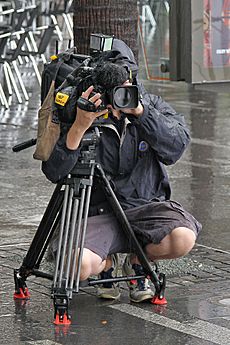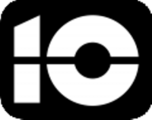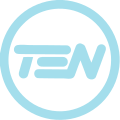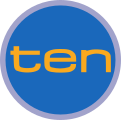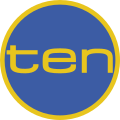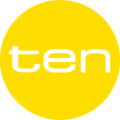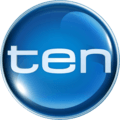Network 10 facts for kids

Logo used since 2018
|
|
| Type | Free-to-air television network |
|---|---|
| Country | Australia |
| Broadcast area | Sydney, Melbourne, Brisbane, Adelaide & Perth |
| Affiliates |
|
| Headquarters | 1 Saunders Street Pyrmont, New South Wales |
| Programming | |
| Language(s) | English |
| Picture format | 1080i HDTV (downscaled to 16:9 576i for the SDTV feed) |
| Ownership | |
| Owner | Paramount Networks UK & Australia (ultimately owned by Paramount Global) |
| Parent | Ten Network Holdings |
| Sister channels |
|
| History | |
| Launched | 1 August 1964 |
| Former names | Independent Television System (1965–1970) The 0-10 Network (1970–1980) Network Ten (1980–1989, 1991–2018) 10 TV Australia (1989–1991) |
| Availability | |
| Terrestrial | |
| TEN Sydney (DVB-T) | 50/251 @ 11 (200.5 MHz) |
| ATV Melbourne (DVB-T) | 50/581 @ 11 (200.5 MHz) |
| TVQ Brisbane/Sunshine Coast (DVB-T) | 50/385 @ 11 (200.5 MHz) |
| ADS Adelaide (DVB-T) | 50/485 @ 11 (200.5 MHz) |
| NEW Perth/Mandurah (DVB-T) | 50/317 @ 11 (200.5 MHz) |
| Freeview 10 owned (virtual) | 10 |
| Freeview 10 HD (virtual) | 1/15 |
| Freeview WIN Regional Northern NSW & Gold Coast (virtual) | 5 |
| Freeview SCA Regional QLD, Southern NSW & ACT, Regional Victoria, Spencer Gulf SA/Broken Hill NSW (virtual) | 5 |
| Streaming media | |
| 10 Play | |
Network 10 (also known as Channel 10 or simply 10) is a major Australian television network. It's a free-to-air channel, meaning you don't need to pay to watch it. Network 10 is owned by Paramount Global, a big media company.
You can watch Network 10 in big cities like Sydney, Melbourne, Brisbane, Adelaide, and Perth. Other TV stations around Australia also show Network 10 programs. Since 2022, Network 10 is usually the fourth most-watched TV network in Australia.
Contents
History of Network 10
Early Days of Australian TV
Before 1965, Australia had two main commercial TV networks and the public ABC. In the early 1960s, the Australian Government decided to allow a third commercial TV station in each major city. This was partly to offer more local shows. The first licence for this new network was given to a group called United Telecasters in 1963.
Australia's TV system was set up like its radio system. The ABC was funded by the government. Commercial networks like Network 10 made money by selling advertising time.
Launching the Network
The first station in this new network was ATV-0 in Melbourne, which started on 1 August 1964. It was owned by Ansett Transport Industries. Then, TEN-10 in Sydney began on 5 April 1965. United Telecasters also launched TVQ-0 in Brisbane and SAS-10 in Adelaide that same year.
The network was first called the Independent Television System. In 1970, it changed its name to The 0-10 Network. This name came from the channel numbers of its first two stations, ATV (channel 0) and TEN (channel 10).
ATV in Melbourne was the first station to test colour TV broadcasts in 1967. The 0-10 Network even used the slogan "First in Colour" in 1974, just before Australia switched to colour TV in March 1975.
Growing Stronger (1970–1988)
In its first few years, the 0-10 Network struggled. But things changed in the early 1970s. In 1971, the network launched Young Talent Time, which was very popular.
A big turning point was the adult soap opera Number 96, which started in March 1972. This show was a huge hit and brought many advertisers to the network. For three years, it was Australia's most-watched TV show.
Even with this success, the Nine Network usually came in first place for ratings, followed by the Seven Network, then 0-10, and finally ABC TV. This pattern continued for many years.
In 1977, media owner Rupert Murdoch bought a large share in Ten Sydney. In 1979, he also gained control of channel 0 in Melbourne. In 1979, the popular soap opera Prisoner also started on 0-10.
On 20 January 1980, the network became Network Ten. This was because ATV in Melbourne moved from channel 0 to channel 10. Brisbane's TVQ-0 also moved to TVQ-10 in 1988. In 1987, Adelaide's SAS-10 and ADS-7 swapped channels. ADS-7 became ADS-10, and SAS-10 became SAS-7.
In 1985, Rupert Murdoch became an American citizen. Because of Australian media laws, he had to sell his TV stations. They were sold to a company called The Northern Star. In 1989, Network Ten was sold again to a group led by Charles Curran.
The network became truly national in 1988 when NEW-10 launched in Perth. This happened because new satellite technology made it easier to broadcast to Western Australia.
Changes and Challenges (1989–1994)
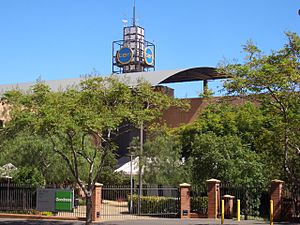
In 1989, Network Ten's ratings were dropping. On 23 July 1989, the network was relaunched as 10 TV Australia. New shows were introduced, but most were cancelled by the end of the year. Only Eyewitness News, Neighbours, and E Street continued.
The company that owned Network Ten, Northern Star Holdings, faced money problems. In September 1989, they sold off the smaller stations in Adelaide, Perth, and Canberra. This split the network in half.
In September 1990, Northern Star faced more financial difficulties. On 13 January 1991, the network changed its name back to Network Ten. By 1992, a Canadian company called Canwest bought a controlling share in the network. In 1992, Network Ten also started focusing on shows for younger audiences. The stations in Adelaide and Perth were bought back by the network in 1995.
Getting Back on Track (1995–2007)
After recovering financially, Ten Network Holdings became a public company in 1998. They made deals with other broadcasters to show their programs in regional areas.
In 2001, Ten launched Big Brother Australia, bringing reality television to Australia. The first night of Big Brother was very popular. Then, in 2003, they launched Australian Idol, a singing competition that was a big hit for many years.
In 2004, Network Ten had one of its best years, winning two rating weeks and coming in second nationally, behind only the Nine Network. This was a big improvement, as they usually placed third.
On 21 August 2005, the network celebrated its 40th birthday with a special show called Ten: Seriously 40.
In 2007, Network Ten made deals with Foxtel and Optus to have its digital signal available on their cable and satellite services. On 16 December 2007, Ten HD was launched. It was the first new commercial TV channel in major Australian cities since 1988.
New Channels and Ownership Changes (2009–2015)
In 2009, Canwest sold its share in Ten Network Holdings. In 2010, businessman James Packer bought a 16% share of Ten.
Network Ten launched a new digital channel called Eleven on 11 January 2011. This channel was for a younger audience (13-29 years old). Popular shows like Neighbours and The Simpsons moved to Eleven.
On 8 May 2011, Ten relaunched its sports channel One. It started showing general entertainment programs aimed at men, similar to 7mate.
In 2012, Ten tried many new shows, but they weren't successful. This caused Ten's ratings to drop. In September 2012, Ten partnered with TVSN, a shopping channel, making it available on Ten's free-to-air service.
In 2013, Ten launched Spree TV, another shopping channel. Analogue TV broadcasts ended in regional areas on 10 December 2013. In 2015, Foxtel bought 15% of Ten Network Holdings.
Affiliation Changes and New Owners (2016–Present)
A high-definition version of 10 was brought back on 2 March 2016. This meant that One (now 10 Bold) started broadcasting only in standard definition.
In 2016, Network Ten made a new deal with WIN Television to broadcast its programs in regional areas. This happened after the Nine Network changed its regional partner.
In 2017, Network Ten faced financial difficulties. On 28 August 2017, the American media company CBS Corporation bought Network Ten. CBS already owned a share in the channel Eleven. This purchase was completed on 16 November 2017.
After CBS took over, Network 10 started making more Australian shows. CBS also wanted to launch its streaming service in Australia. This service, called 10 All Access, launched in December 2018.
On 31 October 2018, the network revealed a new logo. It changed from the word "ten" to a stylish circle with the number "10". The network is now called Network 10. Its other channels, Eleven and One, were also renamed 10 Peach and 10 Boss. 10 Boss later changed its name to 10 Bold due to a trademark issue.
On 4 December 2019, CBS Corporation merged with another media company, Viacom, to form ViacomCBS. Network 10 became part of ViacomCBS Networks UK & Australia. Network 10 also started working with its new sister channel in the UK, Channel 5, to create new shows.
On 13 July 2020, Network 10 announced a third digital channel, 10 Shake, which launched on 27 September. It shows children's programs during the day and "edgy" shows for young adults in the evenings.
In March 2021, 10 announced it would return to Southern Cross Austereo as its regional partner. On 15 February 2022, ViacomCBS changed its name to Paramount Global. Network 10 is now part of Paramount Networks UK & Australia.
On 12 August 2022, Spree TV stopped broadcasting. It was replaced by Gecko, another shopping channel. On 22 June 2023, it was announced that 10 Shake would become Nickelodeon on 1 August.
Programs on Network 10
Network 10 shows a mix of Australian and international programs.
Australian Shows
Some of the popular Australian shows you can watch on Network 10 include:
- Bondi Rescue
- Australian Survivor
- I'm A Celebrity...Get Me Out of Here!
- The Masked Singer Australia
- Gogglebox Australia (with Foxtel's Lifestyle)
- Studio 10
- The Project
- MasterChef Australia
- The Bachelor Australia
- Have You Been Paying Attention?
- Taskmaster Australia
International Shows
Network 10 also shows many programs from overseas. These often come from its sister company Paramount Global Content Distribution and other studios like Warner Bros. International Television Distribution.
In 2017, Network 10 lost its deal with 20th Century Fox. This meant popular shows like The Simpsons and Modern Family moved to other networks. However, in 2018, 10 made a new deal with Warner Bros. and Roadshow Entertainment.
Sharing Programs
Sometimes, different TV networks in Australia share programs. This means the same show or movie series might air on different channels. For example, some American shows are shared between Network 10, the Nine Network, and the Seven Network.
News and Current Affairs
Network 10's news service is called 10 News First. It creates local news bulletins every weekday evening. It also has national news shows on weekday afternoons and weekends.
The news service also produces a nightly discussion show called The Project.
Network 10 can use news footage from its sister network, CBS News, for international stories. They also rebroadcast CBS's morning news program, CBS Mornings, during weekday overnights and Sunday mornings.
Sport on Network 10
Network 10 used to be a big broadcaster of Australian sports. All sports shows on 10 and its other channels are called 10 Sport. Since Paramount Global took over, the channel shows less sports.
From 2002 to 2011, 10 shared the broadcast rights for the Australian Football League (AFL). They showed Saturday afternoon and night games. They also had exclusive rights for all finals games for some years.
In 2003, 10 started broadcasting the Formula One World Championship. From 2013, 10 broadcast all Big Bash League (BBL) cricket games for five years.
10 also showed the 2014 Winter Olympics in Sochi, Russia. In 2018, 10 gained the rights to the Melbourne Cup Carnival horse races. In 2019, 10 broadcast the 2019 Rugby World Cup.
In 2021, 10 got the rights to show various football (soccer) content. This includes the A-League Men and Women competitions. It also includes games for the Socceroos and Matildas. These football games are shown on both Paramount+ and the free-to-air channels.
How to Watch Network 10
Network 10 is available in both standard definition and high definition (1080i HD). The main programs are sent from Melbourne to other Network 10 stations and regional partners. These stations then add their local news and ads.
You can watch Network 10 in major cities through its own stations. In regional Australia, other stations like Southern Cross 10 and WIN Television carry Network 10's programs. You can also watch 10 on Foxtel's cable and satellite services.
10 HD
The 10 HD channel was first launched in 2007, then stopped, and was brought back on 2 March 2016. It shows the same programs as the main 10 channel, but in high definition.
10 Play
10 Play is the network's free online service where you can watch shows you missed (catch-up TV) or stream live. It launched on 29 September 2013. You can use it on computers, phones, smart TVs, and game consoles.
Live streaming of Network 10's main channel started in 2016. Now, you can watch the main channel live 24 hours a day. 10 Bold and 10 Peach also have 24-hour live streams. 10 Shake was added to 10 Play in 2020. In 2022, 10 Play also launched "FAST channels," which are free, ad-supported streaming TV channels.
Paramount+
10 All Access was a subscription streaming service launched in Australia in 2018. It was a local version of CBS All Access from the US. It offered shows from 10 and CBS, plus original programs.
In 2020, after CBS and Viacom merged to form ViacomCBS, they decided to launch a new international streaming service. On 16 September 2020, it was announced that 10 All Access would become Paramount+ in mid-2021. Paramount+ launched on 11 August 2021. It includes movies from Paramount Pictures and shows from various ViacomCBS brands.
Pluto TV
In August 2023, it was confirmed that an Australian version of Pluto TV would be launched within 10 Play. Pluto TV offers free, ad-supported channels. It includes channels for shows like South Park, I Love Lucy, and Happy Days. It also has channels from MTV and Nickelodeon.
Network 10 Logos and Identity
From 1964 to 1984, Network Ten's stations used different logos. There were also some network-wide logos used in the 1960s and 1970s.
By late 1985, most stations used a similar logo: a circle with "TEN" in the middle, looking a bit like a neon sign. This logo was first used by TEN-10 in Sydney in 1983.
On 24 January 1988, many stations adopted the "X TEN" logo. Then, on 23 July 1989, the network rebranded as "10 TV Australia".
On 13 January 1991, the network introduced a new logo with a lowercase "ten" inside a circle. This logo had a few small changes over the next 27 years. In 2008, the logo was updated for HD with a shiny "ball" effect. In 2013, the circle and text became blue.
On 31 October 2018, Ten launched a completely new logo. It replaced the "ten" wordmark with a stylised number "10" in a circle. This new logo is used across all of Network 10's platforms.
Slogans of Network 10
The 0–10 Network (1970–1980)
- 1974–1975: First In Color
- 1977: I Like It!
Network Ten (1980–2018)
- 1980: You're on Top with Ten!
- 1983–1984: You're Home on Ten
- 1988: We're For You!
- 1988–1989: X TEN
- 1989–1991: 10 TV Australia
- 1990–1994: The Entertainment Network
- 1991: That's Entertainment!
- 1993: It's on Ten!
- 1995–1997: Give Me Ten!
- 1998–1999: Turn Me On Ten
- 1999–2000: Ten.
- 2001–2012: Seriously Ten
- 2014–2018: Turn on 10
- 2014: 10, Celebrating 50 Years Young
Network 10 (2018–present)
- 2018–2019: TV with a Twist
- 2019–2020: Now You're Talking
- 2020–2022: There's No Place Like 10
- 2022–present: TV That's So Good
- 2022–present: A Mountain of Entertainment (shared with Paramount+)
See also
 In Spanish: Network 10 para niños
In Spanish: Network 10 para niños
- List of Australian television series
- 10 Peach
- 10 Bold
- Nickelodeon


